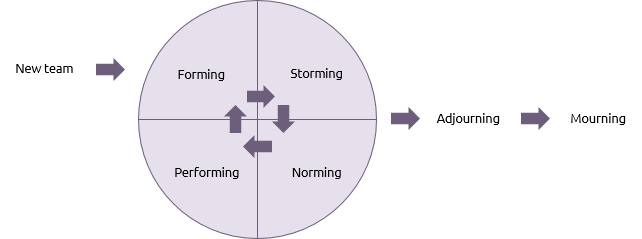Bruce Tuckman first published his model of group dynamics in 1965. It originally comprised the four stages: forming, storming, norming and performing. In 1977 he added the fifth stage: adjourning, and other sources have added a sixth: mourning.

The model is not normally shown as a circle but in the P3 environment managers need to be aware of the potential for the team to slip from performing back to storming, resulting in the manager having to try and quickly move the team through the stages again. This can happen if the work is subject to major change or setbacks; it can occur if there are significant changes to the make-up of the team and the boundaries between stages or tranches is a time when the momentum of team performance can be lost.
- FormingClick here for articles about teamwork
-
The main difference between a random group of people and a team is the team’s common objective. When individuals are first brought together they do not have a common objective. They may be anxious about why they have been brought into this team; they will be hesitant about their new environment, unsure of what they have in common with other team members and confused as to the purpose of the project or programme.
-
Typically, the individuals will indulge in some superficial questioning of colleagues to look for more information, common ground and possible allegiances.
- Storming
-
Different types of individual will behave in very different ways during the forming stage. This will start to bring about conflict between individuals or small sub-groups within the team. The more assertive individuals will try to impose some order by defining rules. This could result in leadership being challenged whilst a ‘pecking order’ is established.
-
Assuming a common purpose has been identified, very different views will arise as to how that purpose should be achieved.
- Norming
-
As the issues and conflicts of the storming stage are resolved, the team starts to settle down and concentrate on tasks and issues rather than personalities. An acceptance of common values and behaviours develops with open communication that promotes constructive review and suggestions for alternatives.
-
The team is starting to become a cohesive unit, truly working as a team with its capabilities being greater than the sum of its parts.
- Performing
-
By this stage the team is working as a focused unit. There is collaboration between team members to solve problems with a visible change in mentality from “me” to “we”. There is a shared responsibility for the common goal and individuals are confident enough to innovate and provide insights into problems, which arise.
-
Individuals demonstrate flexibility, with job titles becoming transparent and delegation of authority working efficiently.
- Adjourning
-
This is the stage that comes as the project or programme commences the closing a project or programme process and demobilisation is near. Some team member’s thoughts may turn to life after the project and therefore they pay less attention to the work in hand.
-
This could be a dangerous time for the manager who is focused on a rapidly approaching deadline and stakeholders who are suddenly more motivated to get involved as the point of handover approaches.
-
Life for team members after the project or programme is out of the manager’s control but the team member’s performance is affected by it. It must therefore be in the manager’s interests to at least work with the team member to allay their concerns.
- Mourning
-
The final stage is possibly mourning. Although there are going to be some projects and programmes that some team members can’t wait to get away from, where the project has been managed well and a team member has worked hard to produce a great result, there will inevitably be a sense of loss.
-
The mourning stage is not so much a problem at the end of the project or programme because it comes after the closure. Its main effect is on the manager of the next piece of work who has to get a group of people together and form a new team, some of whom are mourning the passing of the last team. And so we come full circle.
-
The best approach to motivating these team members is to find out what was good and bad about the last project or programme and encourage them to use their experience to make the current one better.





